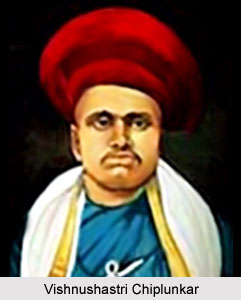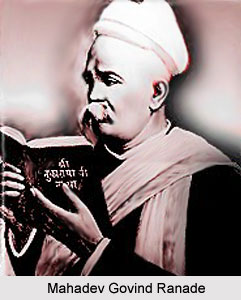 Marathi literature in the late nineteenth century was a mix of several factors that were moulding the life of the Indian people. The period between the demise of the peshwa rule, establishment of the British administration, and 1874 was characterized by a strange mix of strength and vulnerability. A number of changes had been brought in the life of the Indian people which forced them to reconsider their earlier convictions and social customs. There was an increasing spread of periodicals, the introduction of a new educational system which comprised English and the spread of Western social, economic, and political thoughts. The new class of educated people, exposed to Western ideas, began to see the problems and limitations of traditional social structure and relations. The initial attempts at social change had brought about and exposed new cleavages in the society: orthodox and reformist, educated and uneducated, Brahmin and non-Brahmin, rulers and the ruled. All these factors went into determining the literature of the late nineteenth century.
Marathi literature in the late nineteenth century was a mix of several factors that were moulding the life of the Indian people. The period between the demise of the peshwa rule, establishment of the British administration, and 1874 was characterized by a strange mix of strength and vulnerability. A number of changes had been brought in the life of the Indian people which forced them to reconsider their earlier convictions and social customs. There was an increasing spread of periodicals, the introduction of a new educational system which comprised English and the spread of Western social, economic, and political thoughts. The new class of educated people, exposed to Western ideas, began to see the problems and limitations of traditional social structure and relations. The initial attempts at social change had brought about and exposed new cleavages in the society: orthodox and reformist, educated and uneducated, Brahmin and non-Brahmin, rulers and the ruled. All these factors went into determining the literature of the late nineteenth century.
One of the most significant factors during this time was the influence of Vishnushastri Chiplunkar. The son of an eminent scholar, he went on to start his own periodical, `Nibandhamala` in 1874. Through the medium of this publication he sought to educate and galvanise the people by highlighting the various social and political problems of the time. He represented the conservative reaction to reformist tendencies and in his works he attacked the educated people who displayed a subservient attitude towards the British rule. He brought precision, refinement, polish, ease, and compact writing style to the Marathi language. He even started his own printing press, a publishing house and periodicals-a magazine and two newspapers, Kesari (in Marathi) and Maratha (in English). Chiplunkar went on to make a significant contribution to the literary and intrellectual spheres in Marathi.
Another important division that emerged in Maharashtra during the last decade of the nineteenth century was about the objectives of the nationalist movement. Gopal Ganesh Agarkar (1856-95), a colleague of Chiplunkar and Tilak, argued, along with Mahadev Govind Ranade (1842-1901), that social emancipation should take place before the struggle for political freedom was launched. Their liberal views on social and cultural renaissance were at odds with those of Chiplunkar and Tilak. Agarkar broke away from the Kesari organization dominated by Tilak to start his own periodical, `Sudharak`, in 1887. His lucid and rational views on social issues, his humanism, and his deep understanding of historical processes left a profound mark on the middle class and higher castes.
Prose in Late Nineteenth Century
The intellectual turmoil and social change made a deep impression on literature of the period. At the same time, developments in literature reflected and contributed to the process of change under way and mirrored different tendencies manifested during this period. Hari Narayan Apte (1864-1919), the first major Marathi novelist, wrote his first novel, `Madhali Sthiti`, in 1885. It is an adaptation of W. M. Reynold`s `Mysteries of London`. In his novel, Apte depicts the paradox of Western concepts of modernity and the corruption of orthodoxy in the Pune of his times. The title of the novel has been explained as "state of middle classes" or "the transitional stage" In it, Agarkar`s influence, his spirit of social reform, is clearly visible.
His "Pan Lakshyat Kon Gheto?"(1890) blends realism and idealism to trace the life of Yamuna, the narrator, from childhood to maturity. Though clearly a tragedy of Yamuna`s life, it is also an attempt to show the efforts to change women`s lives through education. In this 700-page story, the first-person narrative is used to ensure genuineness. Through a conscious effort, Apte develops the narrative in a halting, recursive style to indicate the limited verbal resources of an uneducated and unsophisticated girl. As the character grows older, she is ready to discuss social conditions and social injustices facing women.
 The differences in the social surroundings of Mumbai and Pune also outline the contradictions of middle-class Marathi life. Mumbai represents, in the novel, a world of social freedom, revival, and individualism while Pune is an orthodox and closed community. Yamuna moves to Mumbai with her husband for two years. Those are the two happy years of her life. There she experiences being herself, away from the constant scrutiny and deception of her joint family in Pune. Through this novel, Apte depicts the subtle inter-mixing of the social and the individual in nineteenth-century Maharashtra, caught up in Brahmin orthodoxy and reform movements.
The differences in the social surroundings of Mumbai and Pune also outline the contradictions of middle-class Marathi life. Mumbai represents, in the novel, a world of social freedom, revival, and individualism while Pune is an orthodox and closed community. Yamuna moves to Mumbai with her husband for two years. Those are the two happy years of her life. There she experiences being herself, away from the constant scrutiny and deception of her joint family in Pune. Through this novel, Apte depicts the subtle inter-mixing of the social and the individual in nineteenth-century Maharashtra, caught up in Brahmin orthodoxy and reform movements.
Apte`s other novels, like `Ganapatrao` (1883), `Mee` (1893-95), and `Jag He Ase Aahe (1897-99),` show his maturity as a novelist attempting to react, reflect, and record the changing social and political environment of Maharashtra. His contribution to the development of the historical novel in Marathi is equally significant. The educated middle class was showing an interest in the history of Maharashtra. It was the reaction of a people who had lost power and had yet to learn to deal with it. As the educated class learned how the Maratha Empire was defeated, it was necessary to restore its will to power. The emergent nationalist ideology helped in the reinterpretation of the history. Apte`s historical novels need to be examined in this context. His first historical novel, `Mysoracha Wagh` (1890), was a shoddy adaptation of an English novel by Meadows Taylor on Tipu Sultan. His Ushakkal (1896) matches the merit of his social novels.
Apte develops splendid images of life during the Maratha period. Since the historical materials relating to the period were yet to be organized, he relied on folklore, legends, gossip, and whatever factual material was available to him to develop the culture of those times. His Ushakkal is distinct as a historical novel in that it depicts a touching picture of the traditional values and norms dominating the lives of an older generation of the Deshmukh family. It also portrays the picture of a younger, idealistic generation with new ideas of self-respect, freedom, and loyalty within that same family. This inter-generational struggle within the family surpasses the intensity of clashes between the Muslims and the Marathas.
Other novelists of the time did not match Apte in his craftsmanship, style, and social consciousness. K. R. Mitra (1871-1920) stands out for his translations of Bengali novels and stories in Marathi. He successfully introduced the gentle emotionalism of Bengali works in Marathi. It was a new element that enriched Marathi fiction. It is also an indication of the process of development of "national" consciousness which was now under way.
Poetry in Late Nineteenth Century
Marathi poetry of the time was liberated from the domination of Sanskrit poetics and the orthodoxy of the Marathi pandit poets of the seventeenth and eighteenth centuries. K. K. Damle, Keshavsut (1866-1905), the son of an ill-paid schoolteacher with a large family, is the one who opened new horizons for Marathi poetry. A contemporary of Hari Narayan Apte, he, too, was influenced by Agarkar`s passion for social reform. His early poetry was influenced by the style and imagery of Sanskrit poetry. As he encountered English poetry, his own work began to reflect new style, words, and expressions. He began to blend the shloka structure in Marathi to the ode. Later, he also experimented with the sonnet and other forms to suit the expression. He was influenced by the English romantic poets, especially Wordsworth. This influence is to be seen in his choice of words, his ability to express his intense feelings as he experienced them and to look at the world from his own perspective. This subjective element was new to Marathi poetry. It is also a reflection of a society that was moving away from group consciousness and identity to a more individualized, self-centered identity. A new awareness of the presence of nature was being expressed in a simple and contemplative manner without resorting to stylized imagery and details. His poems like "Pushpaprat," "Satareeche Bol," "Nairutyekadil Waryas," and "Ek Khede" exhibit these qualities. The other side of his poetry reflects reformist impulses. He felt an urgent need for social reform and for equality among men. His call to action is expressed in his poems like "Tutari" and "Nava Shipai."
If Keshavsut was breaking the molds of traditional poetry, his contemporaries followed different paths. Narayan W. Tilak (1862-1919) was a deeply religious person who rejected Hindu religious orthodoxy and wrote against social injustices, echoing his faith in God and humanity. Vinayak J. Karandikar`s (1872-1909) poetry represents the conservative, romantic reaction rejoicing in the glory of Maratha and Rajput history. As the nationalist movement became stronger, his sentiments enjoyed a wide appeal in Maharashtra. Ram Ganesh Gadkari, (Govindagraj) (1885-1919), T. B. Thombre, )Balakavi) (1890-1918), and Narayan M. Gupte, (Bee) (1872-1947), were other prominent poets of the period, but they did not necessarily follow the lead of Keshavsut.
Drama in Late Nineteenth Century
Between 1885 and 1920, Marathi theatre gained respectability, popularity, and maturity. From the early unscripted plays of Vishnudas Bhave in Sangli through translations and adaptations of Sanskrit and English plays, Marathi drama began to adapt to the new needs and times. The adaptations were now oriented toward performance and were influenced by commercial considerations. Govind Ballal Deval`s (1855-1916) Sharada (1899) is his only original play that truly reflects the concerns of his times. Child marriage, especially very young girls marrying old men, was a burning issue at the time. Sharada uses this issue as its theme not only to criticize this practice and advocate social reform but also to paint a touching picture of the girl`s plight. Deval`s translations of Shakespeare`s Othello as `Zunzarrao` and Moliere`s Sganarelle as `Sanshayakallol` remained popular for a long time.
Shripad Krishna Kolhatkar`s (1871-1934) versatility as a humorist, essayist, novelist, critic, and playwright is commonly acknowledged by critics. His `Mookanayak` (1897) and `Mativikar` (1906) deal with social problems like drinking and widow marriage, but their popularity owed more to music and wit than to the themes. K. P. Khadilkar (1872-1948) was another successful playwright who skillfully blended theme, music, and dialogue in his plays. His `Sawai Madhavravacha Mrutyu` (1893) is a historical play, while `Kichakavadha` (1907) is an adaptation from a story in Mahabharata. The play gained publicity because of the ban by the British. It was argued that the villain of the play resembled Lord Curzon. His Bhaubandaki (1909) uses an episode in history to comment on the rift between the moderate and radical factions at the Surat session of the Indian National Congress. Ram Ganesh Gadkari`s `Ekach Pyala` (1919) and `Bhavabandhan` (1920) were popular for decades for their dialogues, songs, and humor. Marathi theater was already under the control of producers, who were able to assert their will on the playwrights to ensure commercial success.
Thus Marathi literature of the late nineteenth century, as is evident from the above discussion, was mainly a product of the political and intellectual turmoil of the time.













